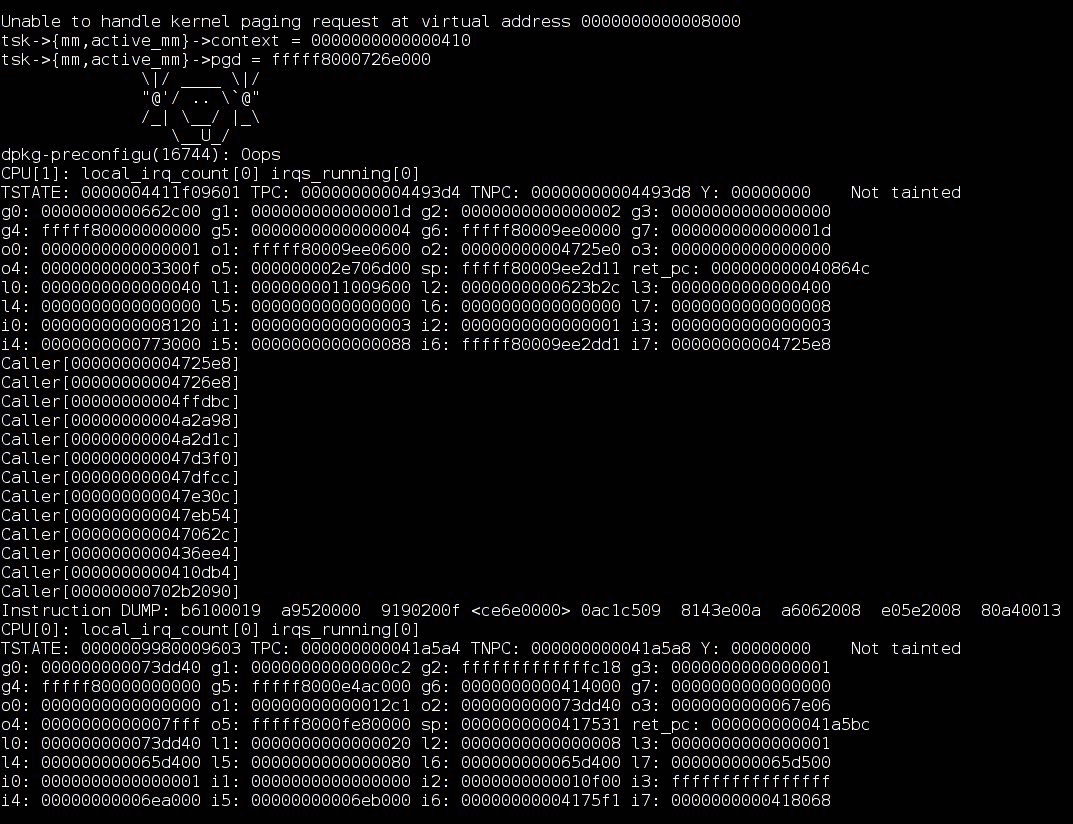|
Linux Kernel Oops
In computing, an oops is a serious but non-fatal error in the Linux kernel. An oops often precedes a kernel panic, but may in some cases allow continued operation with compromised reliability. The term does not stand for anything, other than that it is a simple mistake. Functioning When the kernel detects a problem, it kills any offending processes and prints an ''oops message'', which Linux kernel engineers can use in debugging the condition that created the oops and fixing the underlying programming error. After a system has experienced an oops, some internal resources may no longer be operational. Thus, even if the system appears to work correctly, undesirable side effects may have resulted from the active task being killed. A kernel oops often leads to a kernel panic when the system attempts to use resources that have been lost. The official Linux kernel documentation regarding oops messages resides in the file of the kernel sources. Some logger configurations may affect t ... [...More Info...] [...Related Items...] OR: [Wikipedia] [Google] [Baidu] |
Linux 2
Linux ( or ) is a family of open-source Unix-like operating systems based on the Linux kernel, an operating system kernel first released on September 17, 1991, by Linus Torvalds. Linux is typically packaged as a Linux distribution, which includes the kernel and supporting system software and libraries, many of which are provided by the GNU Project. Many Linux distributions use the word "Linux" in their name, but the Free Software Foundation uses the name "GNU/Linux" to emphasize the importance of GNU software, causing some controversy. Popular Linux distributions include Debian, Fedora Linux, and Ubuntu, the latter of which itself consists of many different distributions and modifications, including Lubuntu and Xubuntu. Commercial distributions include Red Hat Enterprise Linux and SUSE Linux Enterprise. Desktop Linux distributions include a windowing system such as X11 or Wayland, and a desktop environment such as GNOME or KDE Plasma. Distributions intended for servers may ... [...More Info...] [...Related Items...] OR: [Wikipedia] [Google] [Baidu] |
Operating System
An operating system (OS) is system software that manages computer hardware, software resources, and provides common services for computer programs. Time-sharing operating systems schedule tasks for efficient use of the system and may also include accounting software for cost allocation of processor time, mass storage, printing, and other resources. For hardware functions such as input and output and memory allocation, the operating system acts as an intermediary between programs and the computer hardware, although the application code is usually executed directly by the hardware and frequently makes system calls to an OS function or is interrupted by it. Operating systems are found on many devices that contain a computer from cellular phones and video game consoles to web servers and supercomputers. The dominant general-purpose personal computer operating system is Microsoft Windows with a market share of around 74.99%. macOS by Apple Inc. is in second place (14.84%), and ... [...More Info...] [...Related Items...] OR: [Wikipedia] [Google] [Baidu] |
Linux Kernel Mailing List
The Linux kernel mailing list (LKML) is the main electronic mailing list for Linux kernel development, where the majority of the announcements, discussions, debates, and flame wars over the kernel take place. Many other mailing lists exist to discuss the different subsystems and ports of the Linux kernel, but LKML is the principal communication channel among Linux kernel developers. It is a very high-volume list, usually receiving about 1,000 messages each day, most of which are kernel code patches. Linux utilizes a workflow governed by LKML, which is the "bazaar" where kernel development takes place. In his book ''Linux Kernel Development'', Robert Love notes: The LKML functions as the central place where Linux developers around the world share patches, argue about implementation details, and discuss other issues. The official releases of the Linux kernel are indicated by an email to LKML. New features are discussed and most code is posted to the list before any action is tak ... [...More Info...] [...Related Items...] OR: [Wikipedia] [Google] [Baidu] |
System
A system is a group of Interaction, interacting or interrelated elements that act according to a set of rules to form a unified whole. A system, surrounded and influenced by its environment (systems), environment, is described by its boundaries, structure and purpose and expressed in its functioning. Systems are the subjects of study of systems theory and other systems sciences. Systems have several common properties and characteristics, including structure, function(s), behavior and interconnectivity. Etymology The term ''system'' comes from the Latin word ''systēma'', in turn from Greek language, Greek ''systēma'': "whole concept made of several parts or members, system", literary "composition"."σύστημα" Henry George Liddell, Robert Scott, ''A Greek–English Lexicon'', on Per ... [...More Info...] [...Related Items...] OR: [Wikipedia] [Google] [Baidu] |
Kexec
kexec, abbreviated from ''kernel execute'' and analogous to the Unix/Linux kernel call ''exec'', is a mechanism of the Linux kernel that allows booting of a new kernel from the currently running one. Essentially, kexec skips the bootloader stage and hardware initialization phase performed by the system firmware ( BIOS or UEFI), and directly loads the new kernel into main memory and starts executing it immediately. This avoids the long times associated with a full reboot, and can help systems to meet high-availability requirements by minimizing downtime. While feasible, implementing a mechanism such as kexec raises two major challenges: * Memory of the currently running kernel is overwritten by the new kernel, while the old one is still executing. * The new kernel will usually expect all hardware devices to be in a well defined state, in which they are after a system reboot because the system firmware resets them to a "sane" state. Bypassing a real reboot may leave devices i ... [...More Info...] [...Related Items...] OR: [Wikipedia] [Google] [Baidu] |
Kdump (Linux)
kdump is a feature of the Linux kernel that creates crash dumps in the event of a kernel crash. When triggered, kdump exports a memory image (also known as vmcore) that can be analyzed for the purposes of debugging and determining the cause of a crash. The dumped image of main memory, exported as an Executable and Linkable Format (ELF) object, can be accessed either directly through during the handling of a kernel crash, or it can be automatically saved to a locally accessible file system, to a raw device, or to a remote system accessible over network. Internals In the event of a kernel crash, kdump preserves system consistency by booting another Linux kernel, which is known as the ''dump-capture kernel'', and using it to export and save a memory dump. As a result, the system boots into a clean and reliable environment instead of relying on an already crashed kernel that may cause various issues, such as causing file system corruption while writing a memory dump file. T ... [...More Info...] [...Related Items...] OR: [Wikipedia] [Google] [Baidu] |
MacOS
macOS (; previously OS X and originally Mac OS X) is a Unix operating system developed and marketed by Apple Inc. since 2001. It is the primary operating system for Apple's Mac computers. Within the market of desktop and laptop computers it is the second most widely used desktop OS, after Microsoft Windows and ahead of ChromeOS. macOS succeeded the classic Mac OS, a Mac operating system with nine releases from 1984 to 1999. During this time, Apple cofounder Steve Jobs had left Apple and started another company, NeXT, developing the NeXTSTEP platform that would later be acquired by Apple to form the basis of macOS. The first desktop version, Mac OS X 10.0, was released in March 2001, with its first update, 10.1, arriving later that year. All releases from Mac OS X 10.5 Leopard and after are UNIX 03 certified, with an exception for OS X 10.7 Lion. Apple's other operating systems (iOS, iPadOS, watchOS, tvOS, audioOS) are derivatives of macOS. A promi ... [...More Info...] [...Related Items...] OR: [Wikipedia] [Google] [Baidu] |
Microsoft Windows
Windows is a group of several proprietary graphical operating system families developed and marketed by Microsoft. Each family caters to a certain sector of the computing industry. For example, Windows NT for consumers, Windows Server for servers, and Windows IoT for embedded systems. Defunct Windows families include Windows 9x, Windows Mobile, and Windows Phone. The first version of Windows was released on November 20, 1985, as a graphical operating system shell for MS-DOS in response to the growing interest in graphical user interfaces (GUIs). Windows is the most popular desktop operating system in the world, with 75% market share , according to StatCounter. However, Windows is not the most used operating system when including both mobile and desktop OSes, due to Android's massive growth. , the most recent version of Windows is Windows 11 for consumer PCs and tablets, Windows 11 Enterprise for corporations, and Windows Server 2022 for servers. Genealogy By marketing ... [...More Info...] [...Related Items...] OR: [Wikipedia] [Google] [Baidu] |
Patch (computing)
A patch is a set of changes to a computer program or its supporting data designed to update, fix, or improve it. This includes fixing security vulnerabilities and other bugs, with such patches usually being called bugfixes or bug fixes. Patches are often written to improve the functionality, usability, or performance of a program. The majority of patches are provided by software vendors for operating system and application updates. Patches may be installed either under programmed control or by a human programmer using an editing tool or a debugger. They may be applied to program files on a storage device, or in computer memory. Patches may be permanent (until patched again) or temporary. Patching makes possible the modification of compiled and machine language object programs when the source code is unavailable. This demands a thorough understanding of the inner workings of the object code by the person creating the patch, which is difficult without close study of the sourc ... [...More Info...] [...Related Items...] OR: [Wikipedia] [Google] [Baidu] |
Fault (technology)
In document ISO 10303-226, a fault is defined as an abnormal condition or defect at the component, equipment, or sub-system level which may lead to a failure. In telecommunications, according to the Federal Standard 1037C of the United States, the term ''fault'' has the following meanings: #An accidental condition that causes a functional unit to fail to perform its required function. See . #A defect that causes a reproducible or catastrophic malfunction. A malfunction is considered reproducible if it occurs consistently under the same circumstances. See . # In power systems, an unintentional short circuit, or partial short circuit, between energized conductors or between an energized conductor and ground. A distinction can be made between symmetric and asymmetric faults. See Fault (power engineering). Random fault A random fault is a fault that occurs as a result of wear or other deterioration. Whereas the time of a particular occurrence of such a fault cannot be determine ... [...More Info...] [...Related Items...] OR: [Wikipedia] [Google] [Baidu] |

.jpg)

